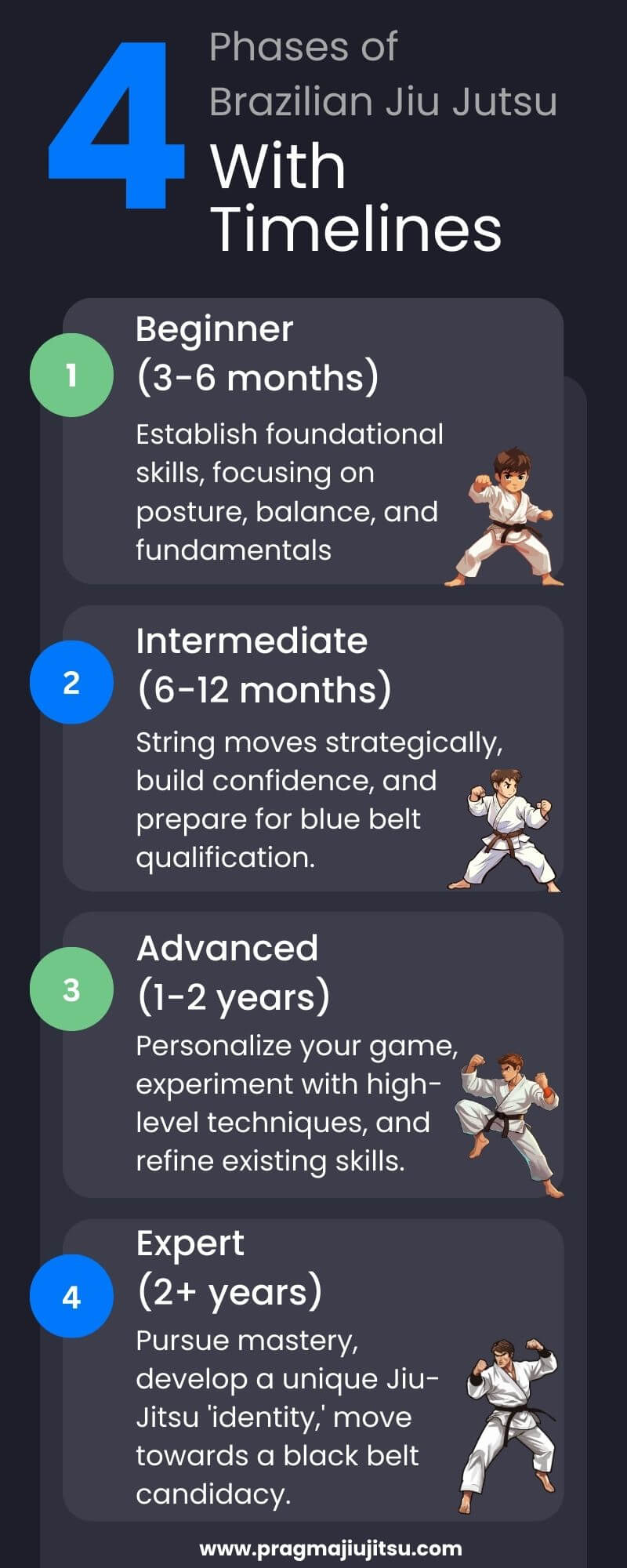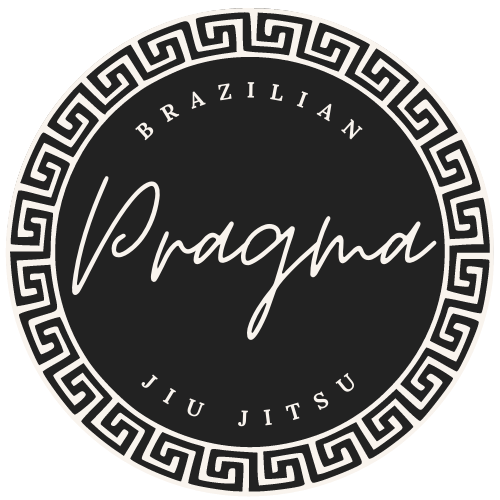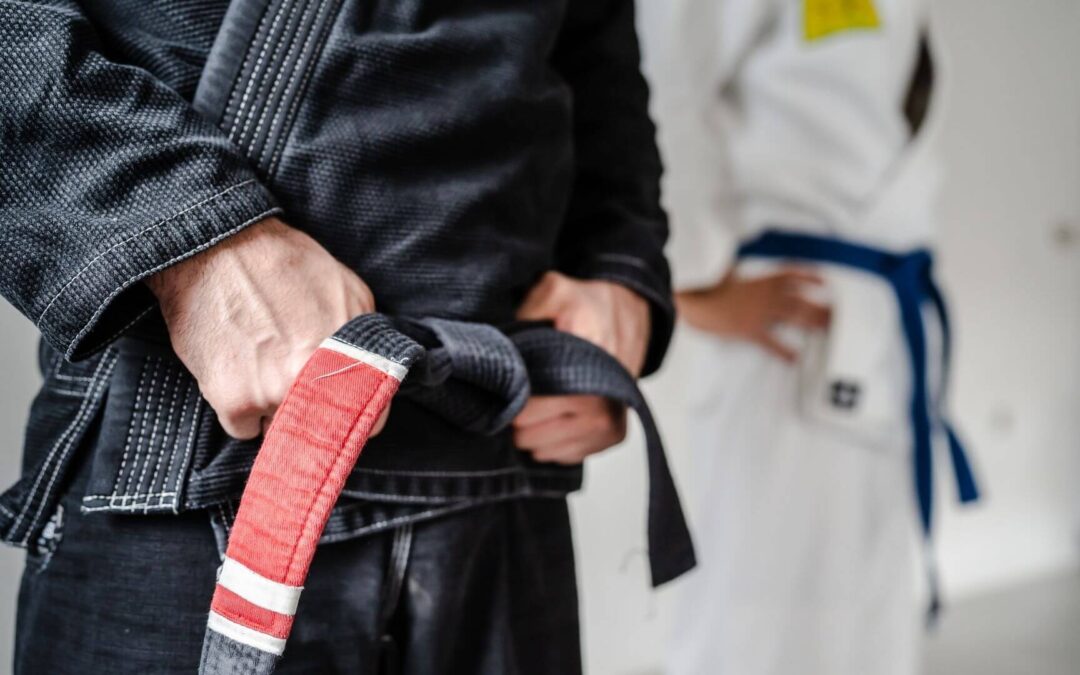It’s natural to question how long the Brazilian Jiu Jitsu journey takes – going from a newbie to mastering this complex art requires time. But stick with consistent training and let the quality teaching light the path.
Each phase influences the next step. The phases and what it usually takes will be discussed, using examples to help visualize the process. Just remember – it’s a journey, so patience and perseverance will serve you well. Every small win is another rung up the belt. Stay with it – you’ll get there!
4 Different Phases of Jiu-Jitsu WIth Timelines:

Phase 1: Beginner (3-6 months)
The journey typically starts with introductory Brazilian Jiu-Jitsu classes in Hutto, and BJJ fundamentals.
In the initial phase of your training, the focus lies primarily on understanding the sport’s fundamental philosophy and acclimating to the foundational techniques. The learning curriculum during the initial months consists of:
- Basics of posture, balance, and movement
- Principles of leverage and body mechanics
- Introduction to ground control positions like the mount, guard, and side control
- Training on defenses, escapes, and essential submissions
Let’s take a detailed look below at the key milestones and training focus during the beginner phase:
| Timeframe | Milestones | Training Focus |
| First Month | Mastering safe falls and fundamental defense postures | Understanding the principles of BJJ, focusing on survival skills |
| Second Month | Practicing essential submissions and escapes | Enhancing defensive skills and initiating basic attacks |
| Third to Sixth Month | Improving ground control, working on transition sequences | Focusing on fluid movements, building robustness in techniques learned |
Progressing through your Brazilian Jiu Jitsu Classes in Hutto is about building upon these fundamentals, mastering new techniques, and seeking growth at every turn.
Phase 2: Intermediate (6-12 months)
As you advance through the Brazilian Jiu-Jitsu school in Hutto, your intermediate phase takes flight. Getting introduced to techniques beyond the basics allows you to start stringing moves together in a more strategic way. Small victories, like escaping a tricky submission attempt or sweeping an opponent from their guard, help build confidence during this time. Sticking with it and consistently practicing the intermediate skills helps take their grappling to the next level.
This period serves as a critical preparation phase for blue belt qualification, having you go deeper into technique efficiency and situational strategy. The table below offers a clearer perspective into the objectives for intermediate learners, highlighting the expertise and skills to be achieved during this phase:
| Objectives | Skills & Techniques | Examples |
| Building upon BJJ Fundamentals | Mid-level escapes and submissions | Elevate your guard; Kimura Lock from half-guard |
| Understanding Fight Strategy | Utilizing leverage and momentum | Reversing positions; countering attacks |
| Mental Toughness | Maintaining composure during sparring | Preventing a tap-out; Defensive posturing |
| Blue Belt Readiness | In-depth knowledge of intermediate techniques | Flawless execution of techniques; Reliable defensive maneuvers |
By the end of this 6- to 12-month period, not only will you notice a considerable leap in your technical prowess, but your strategic understanding of BJJ will also have been amplified.
Phase 3: Advanced (1-2 years)
As you continue to train and gain experience in your dojo, you begin to personalize your game and experiment with different techniques that best suit your style. Comparable to molding a unique signature move, your advanced strategies reflect your growing proficiency and deeper understanding of the art.
This phase requires hard work, consistency, and a continued zeal to progress and innovate. The journey along the path of purple and advanced belts pushes you to explore the depths of concepts, apply strategic thought processes, and pressure-test the execution of established skills.
| Advanced Phase Goals | Examples |
| Progress to high-level techniques | Working on advanced gambits like “Berimbolo” or “Worm Guard.” |
| Fine-tuning existing skills | You are refining. Refine the effectiveness of your Triangle Choke or polish your Sweep technique. |
| Developing a personalized game | You are creating unique combinations that align best with your body type, strength, flexibility, and preferences. |
| Increasing strategic understanding | Better anticipation and control of opponent’s movements, proactive planning of attacks, and improved reaction times. |
Your journey on the mats during the advanced phase is not just about skill acquisition. It also embodies the essence of BJJ – the discipline, the perseverance, the respect for fellow practitioners, and most importantly, the spirit of constant learning.
With your dedication and commitment, your journey from a beginner to this advanced stage takes you through an enriching process of self-growth, physical fitness, and mental resilience.
Phase 4: Expert (2+ years)
Surpassing the two-year mark in your Brazilian Jiu-Jitsu classes in Hutto symbolizes much more than mere continuity – it is the dawn of black belt candidacy and the quest for mastery. At this stage, your assimilated skillset is complimented with a deeper understanding of strategy and nuance – the essence of BJJ expertise.
“Jiu-Jitsu is not about being better than someone else; it’s about being better than you used to be.”
Every sparring session becomes an opportunity to refine your instincts, perfect pressure handling, and define your grappling strategy. Expert learners often display an inherent knack for reading opponents and using their unique stylistic twists to advantage, which is largely attributed to their mastery.
An example of achieving mastery could be successfully (and effortlessly) executing your signature move based on your preferred grappling style and body type, be it the spider guard for flexibility or the half-guard for strategic leverage. Remember, this stage of BJJ is not about learning new techniques but about mastering and personalizing what you’ve learned until now, creating your own unique Jiu-Jitsu ‘identity.’
Have a look at the following table for enhanced comprehension of the objectives at this milestone:
| Objective | Description |
| Black Belt Candidacy | Upon endorsement from the instructor, learners can potentially be candidates for the prestigious black belt. |
| Mastery | Achieving nuanced control, precise timing, and fluidity in technique execution defines true mastery in Jiu-Jitsu. |
| Personalization | Experts begin to personalize their game, integrating preferred techniques and positions into their unique strategy. |
| Jiu-Jitsu ‘Identity’ | Learning at this stage is characterized by identifying and constantly evolving one’s unique Jiu-Jitsu ‘identity.’ |
Excelling in Brazilian Jiu-Jitsu classes in Hutto is a product of your dedication, commitment, and love for the martial art. It holds the promise of life-altering transformation, both on and off the mats.
Factors Affecting Your Speed of Learning Jiu Jitsu:
As you go deeper into your Brazilian Jiu-Jitsu progression, it becomes clear that your journey is not a straight path but a multi-dimensional matrix. The time it takes to reach proficiency isn’t measured solely by years or belt colors. Interlinked facets such as training intensity, grappling background, and inherent athletic prowess create a unique grappling learning curve for each student.
Personal components carry significant weight in how swiftly you progress in your BJJ journey. The sharpness of your technique and the depth of your understanding are fostered by factors that often lie outside the confines of the dojo.
Training Frequency
Training frequency plays a crucial role in accelerating your Brazilian Jiu-Jitsu progression. Regular and consistent BJJ practice can significantly enhance your skill acquisition pace. Whether you’re a beginner getting to grips with the basics or an advanced practitioner perfecting your signature submissions, consistent training is key to your progression.
| Training Frequency | Impact on Skill Acquisition | Role in Skill Retention |
| Training once a week | Slow progress due to lesser exposure to techniques | Increased likelihood of forgetting skills between trainings |
| Training twice a week | Moderate progress with a balanced approach | Improved continuity aids in skill retention |
| Training three or more times a week | Rapid progression with ample time for technique practice | High skill continuity boosts long-term skill retention |
Now that you understand the direct correlation between training frequency and skill development, it becomes abundantly clear why structuring your training schedule is vital.
Training schedule optimization facilitates quicker skill acquisition and fosters long-term retention and implementation of newly acquired techniques in real-time scenarios. A well-structured routine pushes you a step closer to lasting BJJ proficiency.
- Create and stick to your training schedule.
- Ensure you balance your training days with appropriate rest for recovery.
- Gradually increase your training frequency, but avoid overtraining.
Ultimately, the key is striking a balance between adequate practice and rest. Too much rest can hinder your progress, while overtraining might lead to fatigue and injury. Customize your training schedule to fit your lifestyle and needs, ensuring you remain consistent in pursuing your BJJ mastery.
Previous Grappling Experience
Taking Brazilian Jiu-Jitsu classes in Hutto with previous experience in grappling-based martial arts can significantly impact the speed and effectiveness at which one learns new techniques. An extensive grappling background could very well be a secret weapon in enhancing the process of BJJ learning.
For instance, a former wrestler or a judoka might already be familiar with particular movements, locks, or falls, providing them with an edge in understanding and implementing BJJ grappling principles.
This elementary understanding of grappling can tremendously fast-track their BJJ training in Hutto, especially during the early stages.
| Previous Experience | BJJ Learning Enhancement | Comparative Advantage |
| Wrestling | Superior takedown and pinning ability | Increased defense against BJJ-specific submissions due to strong positional control |
| Judo | Understanding of leverage and off-balancing | Ability to transition to groundwork smoothly after executing a throw |
| Sambo | Knowledge of leg locks | Expanded submission arsenal; potential unpredictability during sparring |
While the above are strong advantages, staying humble and being open to learning is essential. Each martial art has challenges that may differ from others.
Natural Athletic Ability
Whether you’re grappling on the mats of a BJJ school in Hutto or participating in a high-intensity tournament, your natural athletic ability can profoundly impact your Brazilian Jiu-Jitsu journey. Everything from your agility and strength to your overall athletic predisposition in BJJ contributes to your learning speed, tactical navigation, and defense techniques.
Let’s consider an example: suppose there’s a student possessing exceptional agility. Due to their nimbleness, they might have an inherent advantage in dodging or escaping submission holds, providing them with an edge during a BJJ bout.
“Athleticism is a key factor that can bolster one’s performance in BJJ combat. But, remember, it should always be complemented with strategic thinking and mastering the correct BJJ techniques.“
| Attribute | Impact |
| Strength | Greater power can allow for effective grappling control and help resist an opponent’s attacks. |
| Agility | Hutto Jiu-Jitsu students with high agility levels can easily maneuver around an opponent, dodge attacks, and execute intricate techniques. |
| Flexibility | Flexibility helps extend one’s range for certain techniques and can aid in escaping tight situations during a match. |
| Coordination | Good coordination can result in the flawless execution of complex movements involved in BJJ techniques. |
It’s noteworthy that while having a naturally athletic predisposition in BJJ is undoubtedly beneficial, patience, diligence, and regular practice also play an instrumental role in achieving proficiency in this martial art.
Work Ethic and Dedication
The essence of mastering Brazilian Jiu-Jitsu goes beyond surface-level training. It requires an unwavering inner drive—the persistence to endure and evolve amid the challenges that the martial art inevitably brings. A steadfast BJJ commitment manifests in various ways, from humble beginnings in Hutto to a global stage.
One crucial element entails a strong work ethic and dedication to continuous improvement. You become a formidable force in this martial art by embracing these elements.
In this context, students who demonstrate the most growth aren’t necessarily those who are naturally gifted but rather the ones who display a relentless pursuit of mastery.
As a student and aspiring BJJ practitioner, this translates into shaping a disciplined daily regime. This regime involves documenting your training sessions, setting achievable goals, and steering a constant self-improvement drive. This meticulous process slowly but surely leads you down the path to continuous martial arts improvement.
| Method | Description |
| Documentation | Record your training sessions. Note your strengths, areas for improvement, and feedback from your coach. Reviewing these notes will extend your learning beyond the dojo. |
| Goal Setting | Construct small, achievable goals. Tackling manageable objectives can lead to significant improvements over time, thus making the vast ocean of BJJ know-how less overwhelming. |
| Persistent Training | With consistency comes proficiency. Regular practice, therefore, is integral in enhancing your techniques and strategies. |
Embed these habits into your BJJ routine, and watch yourself progress from a beginner to an advanced practitioner, bringing you closer to your goal of becoming an efficient martial artist.
Remember, the journey of a thousand miles begins with a single step. The path to martial arts mastery starts with an unshakeable commitment to growth!
School & Instructor Quality
The journey towards mastering Brazilian Jiu-Jitsu is significantly influenced by your choice of martial arts academy and your coach’s expertise. The caliber of your teaching can appreciably shape your progression. As you start your martial art journey, you must look for a top-notch BJJ coaching in Hutto to help you effectively navigate and conquer every phase of learning.
At a reputable martial arts academy like Pragma, you’ll find yourself under the guidance of seasoned coaches with an in-depth understanding of the art’s technicalities. They come with years of experience and possess a wholesome understanding of the sport, thus guiding you effectively through your journey, ensuring you don’t just train hard but smart as well.
An instructor-led BJJ progression can significantly boost your ability to learn and perform techniques correctly, reducing your chances of injury while maximizing your skills.
High-quality instruction in a well-regarded academy usually involves a community of committed learners. This support network can help keep your motivation levels high, improve your training frequency, and further speed up your learning. Below, we’ve outlined some key attributes that exemplify effective instruction:
- Comprehensive knowledge of Brazilian Jiu-Jitsu
- The instructor’s dedication to student growth
- Strong emphasis on technique and form
- Proven history of fine-tuning raw talent
- Availability of advanced training resources
Remember, when it comes to mastering Brazilian Jiu-Jitsu, the quality of education you receive plays a monumental role in determining your proficiency and skill level. Choose your academy and coach wisely to ensure an enriching and fruitful journey. You can talk to the instructors at Pragma and even attend our free Brazilian Jiu Jitsu Classes in Hutto to see them in action before finalizing your decision.

